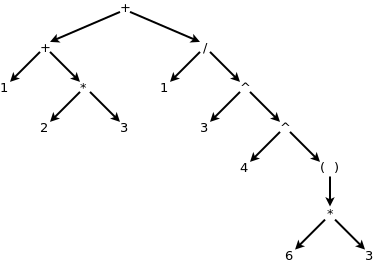4. Expression
An expression is composed of integers, identifiers, and integer mathematical operations.
4.1. Operators
Operation |
Symbol |
Usage |
Associativity |
|---|---|---|---|
exponentiation |
^ |
|
right |
multiplication |
* |
|
left |
division |
/ |
|
left |
remainder |
% |
|
left |
addition |
+ |
|
left |
subtraction |
- |
|
left |
% operator is remainder not modulus.
(rem-not-mod)4.2. Valid Expressions
Valid formats for expressions are
(<expr>)
<expr> <op> <expr>
<int>
<id>
expris an expression.intis an integer.idis the identifier of a variable.
Examples of valid expressions are
i * 2 * 10 + 4
2 ^ 4 * 5
4.3. Precedence
Precedence determines what order operations are evaluated in. Precedence works as defined in the following table:
Precedence |
Operations |
|---|---|
HIGHER |
^ |
* / % |
|
LOWER |
+ - |
The higher the precedence the sooner the value should be evaluated. For example, in the expression
1 + 2 * 3
2 * 3 should be evaluated before 1 + 2. This is because
multiplication, division, and remainder have higher precedence than
addition and subtractions.
4.4. Associativity
When parsing expressions associativity determines in what order operators of the same precedence should be evaluated in. For example:
1 / 2 * 3
In this example both division and multiplication have the same precedence; associativity determines which operations are evaluated first. Left associative operations will form a parse tree like this:
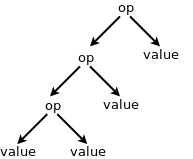
An example of one of these operations is addition. Lets say we have the following expression:
1 + 2 + 3 + 4
Because addition is left associative it will form the following parse tree:
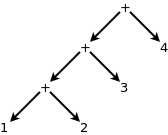
An operation in such a parse tree can only be evaluated when all the
operands are leaves. Thus, in this parse tree, the expression 1 + 2
is evaluated first and then the result of this evaluation replaces the
subtree for the expression 1 + 2 to create the following tree.

Next, the expression 3 + 3 is evaluated, making

Most operations used in this assignment are left associative, but there are also operations that are right associative and take this format:
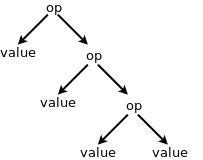
An example of a right-associative operation is the exponentiation
operation represented by the symbol ^. For example
2 ^ 3 ^ 4 ^ 5
should be evaluated as: \(2 ^ {3 ^ {4 ^ {5}}}\)
In order for this expression to be evaluated correctly the following parse tree must be generated
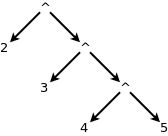
For a more complex example consider the expression:
1 + 2 * 3 + 1 / 3 ^ 4 ^ (6 * 3)
which generates the following parse tree:
